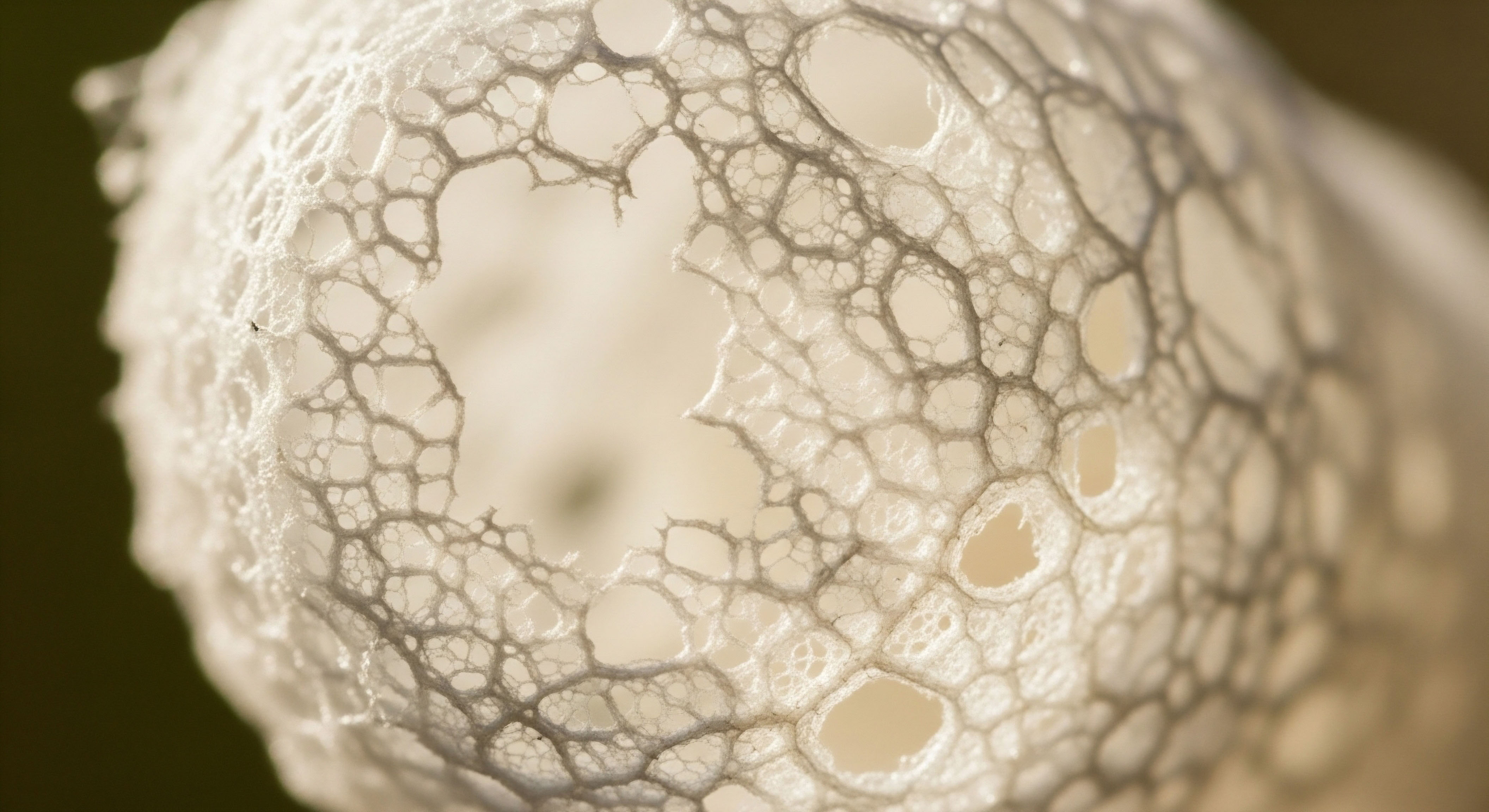

Fundamentals
Many individuals find themselves navigating a subtle yet persistent shift in their overall vitality, a feeling that something fundamental within their biological systems has begun to operate with less precision. Perhaps it manifests as a diminished capacity for physical exertion, a subtle alteration in cognitive sharpness, or a general sense of resilience that feels less robust than before.
These experiences, often dismissed as simply “getting older,” frequently point to deeper, interconnected changes within the body’s intricate messaging network. Understanding these shifts, particularly how our internal chemical messengers influence the very structure of our blood vessels, marks a significant step toward reclaiming optimal function.
The arterial system, a complex network of conduits delivering life-sustaining elements throughout the body, relies on a delicate balance of flexibility and structural integrity. This quality, known as arterial wall elasticity, represents the ability of these vessels to expand and contract with each heartbeat, efficiently propelling blood and maintaining stable blood pressure.
When this elasticity diminishes, arteries stiffen, leading to a cascade of physiological adjustments that can impact overall well-being. This process is not merely a consequence of time; it is profoundly influenced by the endocrine system, the body’s master regulator of internal balance.
Sex hormones, far from exclusively governing reproductive processes, act as powerful systemic regulators, influencing nearly every cell and tissue type, including those comprising the vascular tree. These biochemical messengers, produced primarily by the gonads, exert their influence through specific receptor sites located on various cell types within the arterial wall. Their presence, or absence, dictates a range of cellular activities, from the proliferation of smooth muscle cells to the production of extracellular matrix components like collagen and elastin.
Arterial wall elasticity, a measure of vascular flexibility, is significantly influenced by the body’s sex hormones, which regulate cellular activities within blood vessel structures.
Consider the dynamic nature of arterial walls. They are not inert pipes; rather, they are living tissues constantly adapting to mechanical forces and biochemical signals. The innermost layer, the endothelium, serves as a critical interface, releasing substances that regulate vascular tone and prevent clot formation.
Beneath this lies the media, composed predominantly of vascular smooth muscle cells and elastic fibers, which confer the vessel’s characteristic elasticity. The outermost layer, the adventitia, provides structural support and houses nerves and smaller blood vessels. Each of these layers possesses receptors for sex hormones, indicating their widespread regulatory role.
The primary sex hormones ∞ testosterone, estrogen, and progesterone ∞ each contribute distinctively to vascular health. Testosterone, often associated with male physiology, is also present and biologically active in females, albeit at lower concentrations. Estrogen, predominantly a female hormone, also plays a role in male physiology through its conversion from testosterone.
Progesterone, primarily a female reproductive hormone, also holds significance for vascular function. Understanding their individual and synergistic actions on arterial tissue provides a clearer picture of how these internal messengers shape our vascular resilience.


Intermediate
The intricate interplay between sex hormones and arterial wall elasticity extends beyond simple presence or absence; it involves complex signaling pathways that modulate cellular function within the vascular system. These hormones act as finely tuned conductors, orchestrating the behavior of vascular smooth muscle cells, endothelial cells, and fibroblasts, which collectively determine the mechanical properties of arteries. When this orchestration falters, the vascular system can lose its optimal rhythm, leading to reduced compliance and increased stiffness.
Testosterone, a potent androgen, exerts a multifaceted influence on arterial walls. In physiological concentrations, it appears to support vascular health by promoting vasodilation, a widening of blood vessels that improves blood flow. This effect is partly mediated by its interaction with androgen receptors on vascular smooth muscle cells, leading to the relaxation of these cells.
Testosterone also influences the balance between collagen and elastin production within the arterial wall. A healthy artery maintains a precise ratio of these structural proteins, with elastin providing flexibility and collagen providing tensile strength. Imbalances can lead to either excessive rigidity or undue fragility.
Estrogen, particularly estradiol, is widely recognized for its protective effects on the cardiovascular system, especially in pre-menopausal females. Its actions on arterial elasticity are significant. Estrogen promotes the synthesis of nitric oxide (NO) by endothelial cells, a powerful vasodilator that helps maintain arterial flexibility.
It also influences the extracellular matrix, potentially reducing collagen deposition and promoting elastin integrity, thereby preserving the elastic properties of the arterial wall. The decline in estrogen levels during perimenopause and post-menopause often correlates with an increase in arterial stiffness, underscoring its protective role.
Sex hormones, including testosterone and estrogen, modulate arterial elasticity by influencing vascular smooth muscle cell relaxation, nitric oxide production, and the balance of structural proteins like collagen and elastin.
Progesterone, while less studied in its direct effects on arterial elasticity compared to estrogen, also contributes to vascular health. It can influence vascular tone and may modulate the effects of estrogen on the arterial wall. Its presence is particularly relevant in female hormone optimization protocols, where it is often co-administered with estrogen to maintain physiological balance and mitigate potential risks associated with unopposed estrogen.

Optimizing Hormonal Balance for Vascular Resilience
Clinical protocols aimed at optimizing hormonal balance, such as Testosterone Replacement Therapy (TRT) for men and women, and specific female hormone balance protocols, are designed to restore physiological levels of these critical messengers. These interventions are not merely about addressing symptoms; they represent a strategic recalibration of the endocrine system to support systemic health, including vascular integrity.
For men experiencing symptoms of low testosterone, a standard TRT protocol often involves weekly intramuscular injections of Testosterone Cypionate. This approach aims to bring testosterone levels into an optimal physiological range, which can have beneficial effects on vascular function. To maintain natural testosterone production and fertility, Gonadorelin is frequently included, administered via subcutaneous injections twice weekly.
Anastrozole, an aromatase inhibitor, is also often prescribed twice weekly as an oral tablet to manage the conversion of testosterone to estrogen, preventing potential side effects associated with elevated estrogen levels in men. In some cases, Enclomiphene may be added to support luteinizing hormone (LH) and follicle-stimulating hormone (FSH) levels, further aiding endogenous hormone production.
Female hormone balance protocols are tailored to address the unique needs of pre-menopausal, peri-menopausal, and post-menopausal women. For women, Testosterone Cypionate is typically administered in much lower doses, often 10 ∞ 20 units (0.1 ∞ 0.2ml) weekly via subcutaneous injection. This lower dose aims to optimize testosterone levels without inducing virilizing effects, while still providing systemic benefits, including potential support for vascular health.
Progesterone is prescribed based on menopausal status, often cyclically for pre-menopausal women or continuously for post-menopausal women, to ensure a balanced hormonal environment. Pellet therapy, offering long-acting testosterone delivery, is another option, with Anastrozole considered when appropriate to manage estrogen levels.

Targeted Peptide Therapies and Vascular Support
Beyond traditional hormone optimization, certain peptide therapies are gaining recognition for their potential to support various physiological functions, some of which indirectly contribute to vascular health and tissue repair. While not directly targeting arterial elasticity in the same way as sex hormones, their systemic effects can be complementary.
For active adults and athletes seeking anti-aging benefits, muscle gain, fat loss, and sleep improvement, Growth Hormone Peptide Therapy is a consideration. Peptides like Sermorelin, Ipamorelin / CJC-1295, Tesamorelin, Hexarelin, and MK-677 stimulate the body’s natural production of growth hormone. Growth hormone itself plays a role in tissue repair and regeneration, which can indirectly support the health and integrity of vascular structures over time.
Another peptide, Pentadeca Arginate (PDA), is specifically utilized for tissue repair, healing, and inflammation modulation. By supporting cellular regeneration and reducing inflammatory processes, PDA could contribute to a healthier vascular environment, indirectly supporting arterial wall integrity and function.
| Hormone | Primary Vascular Effect | Cellular Mechanism |
|---|---|---|
| Testosterone | Vasodilation, structural protein balance | Androgen receptor activation on smooth muscle cells, modulation of collagen/elastin synthesis. |
| Estrogen (Estradiol) | Nitric oxide production, reduced stiffness | Endothelial NO synthase activation, influence on extracellular matrix composition. |
| Progesterone | Vascular tone modulation, estrogen interaction | Receptor-mediated effects on smooth muscle cells, potential synergistic actions with estrogen. |
These protocols represent a proactive approach to maintaining physiological balance, recognizing that the body’s systems are deeply interconnected. By addressing hormonal deficiencies and optimizing their levels, we aim to support not only subjective well-being but also the fundamental structural and functional integrity of vital systems, such as the arterial network.


Academic
The profound influence of sex hormones on arterial wall elasticity extends to the molecular and cellular levels, involving intricate signaling cascades that regulate vascular remodeling and function. This systems-biology perspective reveals that arterial stiffness is not merely a passive consequence of aging but an active process modulated by the endocrine environment. A deeper examination of these mechanisms provides a comprehensive understanding of how hormonal status directly impacts vascular resilience.
The arterial wall’s mechanical properties are determined by the composition and organization of its extracellular matrix (ECM), particularly the ratio of elastin to collagen fibers. Elastin provides the distensibility necessary for arterial compliance, allowing vessels to expand and recoil with pulsatile blood flow. Collagen, conversely, provides tensile strength and limits overdistension.
An imbalance favoring collagen deposition or cross-linking, or degradation of elastin, leads to increased arterial stiffness. Sex hormones exert direct control over the synthesis and degradation of these critical ECM components.

Molecular Mechanisms of Hormonal Action on Vascular Cells
Estrogen, primarily 17β-estradiol, mediates its vascular effects through both genomic and non-genomic pathways. Genomic effects involve binding to estrogen receptors (ERα and ERβ) located in the nucleus of vascular cells, including endothelial cells and vascular smooth muscle cells (VSMCs). This binding initiates gene transcription, leading to the synthesis of proteins that influence vascular function.
For instance, estrogen upregulates the expression of endothelial nitric oxide synthase (eNOS), the enzyme responsible for producing nitric oxide (NO). NO is a potent vasodilator and an anti-atherosclerotic molecule that helps maintain arterial compliance by relaxing VSMCs and inhibiting their proliferation.
Non-genomic effects of estrogen occur rapidly, independent of gene transcription, and involve membrane-bound estrogen receptors or direct interaction with signaling molecules. These rapid actions can lead to immediate vasodilation by activating intracellular signaling pathways, such as the phosphatidylinositol 3-kinase (PI3K)/Akt pathway, which phosphorylates and activates eNOS. This dual mechanism of action ∞ long-term genomic regulation and rapid non-genomic responses ∞ underscores estrogen’s comprehensive role in maintaining arterial elasticity.
Testosterone’s influence on arterial elasticity is equally complex. While often associated with potential pro-atherogenic effects at supraphysiological levels, physiological testosterone concentrations appear to be vasculoprotective. Testosterone can directly bind to androgen receptors (AR) on VSMCs, leading to their relaxation and vasodilation.
It also influences the expression of various growth factors and cytokines that modulate VSMC proliferation and migration, processes critical to vascular remodeling. Some research suggests testosterone may also indirectly affect NO bioavailability or influence the activity of matrix metalloproteinases (MMPs), enzymes involved in ECM turnover. The balance between testosterone and estrogen, particularly the aromatization of testosterone to estradiol, is a critical determinant of overall vascular health in both sexes.

Interplay with Metabolic Pathways and Inflammation
The endocrine system does not operate in isolation; its influence on arterial elasticity is deeply intertwined with metabolic health and systemic inflammation. Hormonal imbalances can exacerbate metabolic dysregulation, such as insulin resistance and dyslipidemia, which are known contributors to arterial stiffening. For example, low testosterone in men is frequently associated with metabolic syndrome, a cluster of conditions that includes abdominal obesity, high blood pressure, and impaired glucose metabolism, all of which negatively impact vascular compliance.
Chronic low-grade inflammation also plays a significant role in the progression of arterial stiffness. Inflammatory cytokines can induce endothelial dysfunction, promote VSMC proliferation, and alter ECM composition. Sex hormones possess anti-inflammatory properties that can mitigate these detrimental effects. Estrogen, for instance, can suppress the expression of pro-inflammatory molecules and reduce oxidative stress within the vascular wall.
Optimizing hormonal balance through targeted protocols can therefore indirectly improve arterial elasticity by ameliorating underlying metabolic and inflammatory drivers of vascular dysfunction.
| Cell Type | Hormone | Key Molecular Target/Pathway | Effect on Arterial Elasticity |
|---|---|---|---|
| Endothelial Cells | Estrogen | eNOS expression, NO production (genomic & non-genomic) | Increased vasodilation, improved compliance |
| Vascular Smooth Muscle Cells | Testosterone | Androgen Receptor (AR) activation, ion channel modulation | VSMC relaxation, reduced stiffness |
| Fibroblasts | Estrogen, Testosterone | Collagen/Elastin synthesis and degradation enzymes (MMPs, TIMPs) | Modulation of extracellular matrix composition |
| Immune Cells (within vascular wall) | Estrogen | Cytokine expression, inflammatory signaling | Reduced inflammation, protection against stiffening |

Clinical Implications and Personalized Protocols
The understanding of these complex mechanisms underpins the rationale for personalized wellness protocols. For men, the strategic application of Testosterone Replacement Therapy (TRT), often combined with agents like Gonadorelin to preserve testicular function and Anastrozole to manage estrogen conversion, aims to restore a hormonal milieu conducive to vascular health. The goal extends beyond symptom relief to include the maintenance of arterial compliance and overall cardiovascular resilience.
Similarly, for women, carefully calibrated protocols involving Testosterone Cypionate (at lower doses) and Progesterone, alongside estrogen when appropriate, seek to re-establish a hormonal environment that supports vascular integrity throughout the lifespan, particularly during and after the menopausal transition. The precise titration of these agents, guided by comprehensive laboratory assessments, allows for a highly individualized approach that respects the unique physiological landscape of each person.
Personalized hormone optimization protocols, informed by detailed molecular understanding, aim to restore physiological balance to support arterial elasticity and overall vascular health.
The integration of growth hormone-releasing peptides, such as Sermorelin or Ipamorelin / CJC-1295, can further support systemic tissue repair and regeneration, which indirectly benefits vascular structures. These peptides, by stimulating endogenous growth hormone secretion, contribute to cellular turnover and maintenance, potentially aiding in the long-term preservation of arterial wall integrity. The scientific literature continues to expand on the precise molecular targets and systemic effects of these peptides, providing further avenues for supporting optimal physiological function.
Ultimately, the journey toward reclaiming vitality involves a deep appreciation for the body’s intricate communication systems. By precisely recalibrating hormonal signals, we can influence fundamental biological processes, such as the dynamic elasticity of our arterial walls, paving the way for sustained health and robust function.

References
- Mendelsohn, Michael E. and Richard H. Karas. “The protective effects of estrogen on the cardiovascular system.” The New England Journal of Medicine 340.23 (1999) ∞ 1801-1811.
- Dubey, R. K. et al. “Estrogen and vascular smooth muscle function.” Cardiovascular Research 53.3 (2002) ∞ 688-698.
- Jones, T. Hugh, et al. “Testosterone and cardiovascular risk in men.” Maturitas 71.1 (2012) ∞ 16-22.
- Traish, Abdulmaged M. et al. “The dark side of testosterone deficiency ∞ II. Type 2 diabetes and metabolic syndrome.” Journal of Andrology 30.1 (2009) ∞ 23-32.
- Vanhoutte, Paul M. et al. “Endothelial dysfunction and vascular disease.” Journal of Cardiovascular Pharmacology 47 (2006) ∞ S205-S213.
- Reckelhoff, Jane F. “Gender differences in the regulation of blood pressure.” Hypertension 37.5 (2001) ∞ 1199-1208.
- Rosano, Giuseppe M. C. et al. “Cardiovascular effects of testosterone in men.” European Heart Journal 31.18 (2010) ∞ 2197-2204.
- Miller, Virginia M. and Stephen J. T. O’Rourke. “Sex hormones and vascular function.” Journal of Applied Physiology 91.5 (2001) ∞ 2378-2384.

Reflection
Considering the profound influence of our internal chemical messengers on the very fabric of our being, particularly the resilience of our arterial system, invites a deeper introspection into one’s own health journey. This exploration of how sex hormones shape arterial wall elasticity is not merely an academic exercise; it is an invitation to view your body as a dynamic, responsive system capable of recalibration.
The knowledge shared here serves as a starting point, a framework for understanding the intricate connections that govern your vitality.
Recognizing the subtle signals your body sends ∞ whether it is a shift in energy, a change in recovery, or a general sense of diminished function ∞ is the first step toward proactive engagement with your well-being.
This understanding empowers you to ask more precise questions, to seek guidance that respects your unique biological blueprint, and to consider personalized strategies for optimizing your physiological landscape. Your path toward sustained health is a personal one, and it begins with informed awareness and a commitment to understanding your own biological systems.



